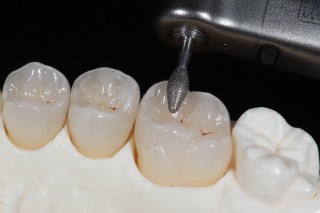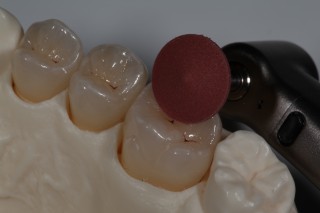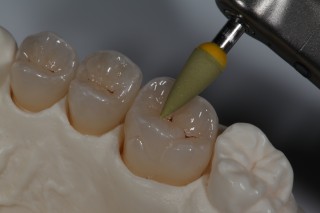Clinical Tips for Polishing Ceramics: e.max and Zirconia
Adjusting occlusal contacts is frequently required at the time of try-in and/or post-insertion. If a minor occlusal adjustment is needed, I suggest using only a rubber abrasive polishing wheel, not a diamond. A diamond is needed only if a significant adjustment is needed.
If a diamond is used in this process, properly polishing the surface is necessary to achieve a smooth surface. A polished ceramic surface is less abrasive than one that is glazed, so there should be no need for reglazing the restoration. The larger the diameter of the polishing wheel used, the more efficient and effective the process. A point may be necessary to get into the depth of the anatomy; however, it is the least effective because of its size.
3 key points for polishing ceramics
Diamond
Use a fine-grit diamond in a friction-grip, slow-speed handpiece. An electric handpiece is more effective than one that is air-driven. Run the handpiece at 20,000 RPM with water spray. Avoid a high-speed handpiece, because it will create excessive heat and trauma in the ceramic. A light touch is required to avoid excessive heat and vibration. You will then need to use a rubber polishing wheel.

Rubber polishers
I use Brasseler’s Dialite LD (lithium disilicate) and ZR (zirconia) series. Each has a medium- and a high-luster wheel. An electric handpiece should run at 10,000–15,000 RPM, with only light pressure used. Electric handpieces have constant torque even at a slow speed, so they are more effective than air-driven handpieces. Begin the process with the medium-luster wheel. This step should take approximately 30 seconds. Next, use the high-luster rubber wheel using the same technique described above.


Polishing paste
Polishing paste should be used with a bristle brush wheel in a slow-speed latch handpiece. The product I use is the Dental Ventures of America Zircon-Brite “G.” It’s very effective for polishing the grooves in the posterior anatomy.
Happy polishing!
SPEAR NAVIGATOR
Transform how your practice runs by engaging the team through
coaching and training
A guided path to excellence through structured coaching and self-guided resources that will align your team, streamline processes and drive growth. Transform your practice by implementing Spear’s proven playbooks for developing and retaining a high-performing dental team.

By: Robert Winter
Date: August 2, 2012
Featured Digest articles
Insights and advice from Spear Faculty and industry experts


